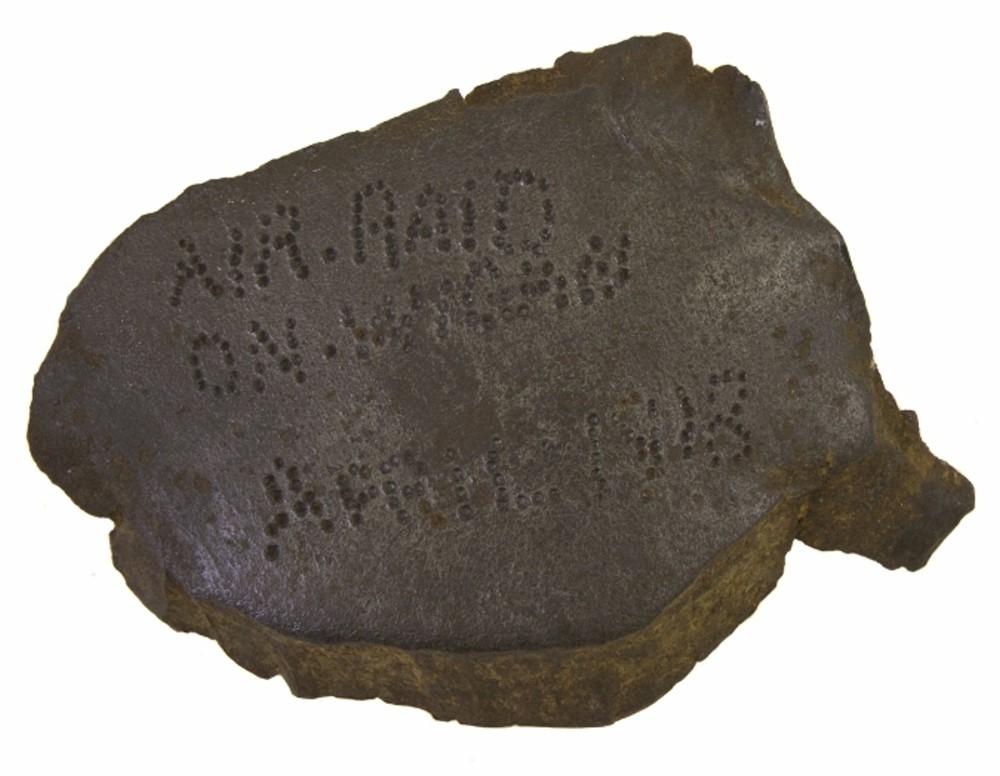Wigan Album
ZEPPELIN RAID 1918
7 Comments
Photo: RON HUNT
Item #: 30783
From a bomb dropped on Wigan by a zeppelin in April 1918.
Piece of shrapnel from the bomb dropped by a German zeppelin in an air raid on Wigan in April 1918.
The details have been engraved on the piece by William Chivers of Scholes.
Zeppelin Shrapnel
On the 12 April 1918 at 3:07pm, zeppelin L61 set off from her base at Wittmundhaven, located on the North German Coast. This was one of five zeppelins that were ordered to raid 'Middle England'. However, the overcast and foggy conditions within England that night meant that the L61 narrowly failed to reach its initial objective of Liverpool. Her commander, Ehrlich, who died in 1921, never realised how close he came to his objective.
The L61 wound up bombing Wigan primarily due to the fact that the commander spotted a glare coming from the six blast furnaces of the Wigan Coal and Iron Company, which was locally known as 'Top Place' and was located in Kirkless, on the eastern outskirts of Wigan. Ehrlich mistakenly wrote in his log that he had bombed Sheffield rather than Wigan.
Arriving over Wigan, the L61 dropped its first bomb just above Preston Street, short of Britannia Canal Bridge and Railway Bridge. One house was damaged. A second missile was then dropped moments after, damaging a signal box on the embankment, just east of the bridge. The airship then released a salvo of bombs as it crossed the Leeds and Liverpool Canal. The first of the bombs, which landed at the bottom of Hartley Avenue, fortunately, failed to explode. However, the next three were much more serious. One bomb exploded at the cross-section of Harper Street and Clarington Grove; creating a crater that measured 8ft wide and 6ft deep. This has since been turned into a playing field. Another bomb was dropped a few yards away from Clarington Grove.
Jack McCann was an eight year old boy who lived in the house opposite the crater. As the bomb exploded, part of the window frame unfortunately came loose and hit him in the head, rendering him unconscious.
The fourth missile of the salvo hit a terraced house on Harper Street. This was the home of Mr Tomlinson, a local gas meter inspector, and his wife. They both died instantly due to the impact of the bomb. Their house, along with two others, were destroyed. Mary Helen More, a neighbour of the couple and a devout Roman Catholic, survived and told the story that, upon her ruined wall, her picture of Christ remained perfectly intact and exposed to the public. The 'Big Lamp' was the next landmark to be hit by a bomb. It was a cast-iron street gaslight that was often used as a local meeting place and stood at the junction of Hardybutts, Birkett Bank and Scholefield Lane. Lethal fragments of the lamp hit nearby buildings as it received a direct hit from the bomb. One splinter entered through a fanlight and stopped the clock at the end of the lobby in the Birkett Bank Hotel.
There were many narrow escapes but an occupant of one cottage had to be taken to hospital unconscious with serious injuries to the face. A few moments later, the L61 dropped a bomb on Platt Lane, causing another fatality as, Mrs Margaret Ashurst, mother of five and wife of a miner, was killed.
At number 187 Whelley Brow , Walter Harris was bringing his infant son downstairs at the point of impact. A splinter hit the both of them and they both lost their lives.
The final four bombs were released along a brook on the Wigan side of the Leeds and Liverpool Canal Bridge, at New Springs. The bombs destroyed multiple greenhouses in its path and their contents.
Overall, the bombardment lasted for 12 minutes, yet the bombs and their affects still managed to take the lives of seven people and injure nine.
Sources:
Zeppelins Over Lancashire by Peter J.C.Smith
An aerial map I posted in 2011, showing just where the bombs fell is "available" if you go to ASSORTED and then ZEPPELIN RAID 1918. Can't tell where the shrapnel might have come from.
My Mam lived in Harper St at the time as a little one,she said they found her under the table,and..my Dad uses to have a piece of shrapnel,but I don't know what happened to it.
Wasn't it found out not to be shrapnel but a piece of iron drainpipe from one of the damaged houses.
Tom it looks a bit to flat and thick for it to be a drainpipe
To thick for it to be a bomb are a drainpipe, its probably just a piece of scrap iron from the bottom of one of the furnace buckets
There is a similar photograph of a fragment of a world war 1 bomb on show at the National War Museum of Scotland in the November edition of The Scots Magazine just received. The text reads that the family of the soldier killed by it in 1916 was sent it amongst his possessions 100 years ago.It was donated to the museum by the family for the exhibition. The texture of the metal is the same as shown in the Wigan photo.